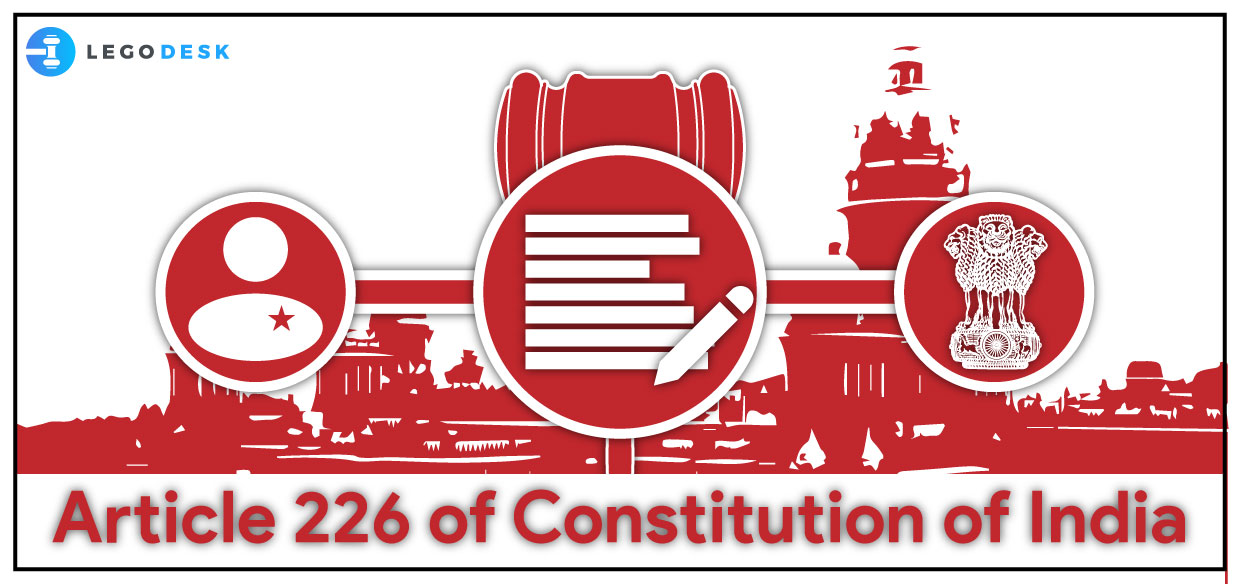Introduction To Article 26
As per the powers conferred under Article 226 of Indian Constitution, High Courts have the power to issue directions, orders, writs to any person or authority or any governmental authorities (in appropriate cases).
Fundamental Rights frame the rampart of The Constitution of India. Each of these rights is sacrosanct. It would be trivial if there exists no instrument to authorize them. Article 32 and 226 gives us the component of Right to Constitutional Remedies.
The power conferred under Article 226(1) and Article 226(2)
As per the provision, notwithstanding anything contained under Article 32, High courts have the authority in the territory where their jurisdiction is exercised to issue directions order or writs in the nature of Mandamus, Habeas Corpus, certiorari, quo warranto, prohibitions.
In legal terms, a writ is a formal written order issued by a government entity in the name of sovereign authority. In modern parlance, this government entity is a court.
Types of Writs issued under Article 226(1)
1. Habeas Corpus ( you may have the body)
This is in the nature of an order calling upon the person who has detained another to produce the latter before the court, in order to let the court know on what ground he has been detained and to release the person from the detention if there is no legal justification for the confinement.
2. Mandamus (the order)
It is used to compel the lower court or a governmental officer or any other body to discharge their duty on time. It is used to impart justice when there is any wrongful exercise of a power or a refusal to perform duties. Writ of Mandamus strictly follows the rule of Locus Standai. In India, writ of mandamus can be issued against the government also as article 226 and 331 embodies the principle that appropriate proceedings can be brought against the government concerned. However, the courts have been unwilling to issue the writ of mandamus against high dignitaries like the president and Governor.
3. Prohibition (Stay order)
A writ of prohibition is issued to a lower court or a body to stop acting beyond its powers. It is preventive in nature. The main essence is to secure that the jurisdiction of an inferior court or tribunal is exercised and it does not act beyond its jurisdiction. Thus, this writ is available during the ongoing proceeding and before the order is made.
4. Certiorari (We command)
It is issued against the acts or proceedings of a judicial or quasi-judicial body conferred with power to determine the question affecting the rights of subjects and obliged to act judicially. It is both curative and preventive in nature. With the issuance of this writ decision given by a lower court which affects the rights of subjects and quashes this order.
5. Quo Warranto (What is your authority)
It is issued to inquire about the legality of a claim by a person or authority to act in a public office when he/she is not entitled to. In this case, proceedings review the actions of the administrative authority. The principle of Locus Standai is flexible here, a writ of Quo Warranto can be filed by any person, though not being an aggrieved party.
Powers conferred under Article 226(3)
This clause was brought by the 44th constitutional law amendment act, 1978. Wherein it has been introduced that in a case concerning ex parte interim order by way of injunction or stay or any order furnished by the court, without furnishing to such party copies of such petition and all documents in support of the plea for the interim orders and without giving such party an opportunity of being heard.
The main object of the insertion of clause (3) to Article 226 of the Constitution provides an opportunity to the respondents and the matter to be brought before the notice of the Hon’ble judge. An application for vacating the ex-parte interim orders are to be filed in the registry as per the Court Norms. After registering the cases, the Advocates do not get it listed down in the court or either of the advocates seeks an adjournment. As a result, the court is not able to take cognizance of such ex-parte interim orders. Hence to avoid such circumstances, Article 226(3) was issued. Two weeks from the time this application is registered or from the time it is issued, whichever is later, High Court is supposed to dispose of such applications.
Legal prerequisites for moving an application under Article 226(3)-
- A writ petition filed against the respondent party.
- Interim order by way of injunction or stay has been passed against respondents party without (a) furnishing to such party, copies of the petition and all documents in support thereof (b) giving such party an opportunity of being heard.
- If the respondent party files an application for disposal of an interim order and furnish a copy of such application asking for the disposal to the petitioner. After bringing the matter in the notice of the petitioner, the court is supposed to adjudicate the matter within 2 weeks.
Powers conferred under Article 226(4)
Not considering the powers conferred under Article 32, every high court shall have the authority to issue writs. This power conferred on a High Court is not in derogation of the power conferred on the Supreme Court under article 32(2). This implies that if a person not satisfied with the judgment of the Hon’ble High Court can appeal to the Supreme Court under article 32 of the Constitution of India.
Conclusion
While acting under Article 226, the High Court doesn’t sit or act as an appellate authority over the orders/actions of the subordinate authority. This jurisdiction is supervisory in nature. One of the essential reason for this jurisdiction is to keep the government and tribunals within bounds of their respective jurisdiction. High Courts must ensure that while performing this function it does not overstep the well-recognized bounds of its own jurisdiction.

